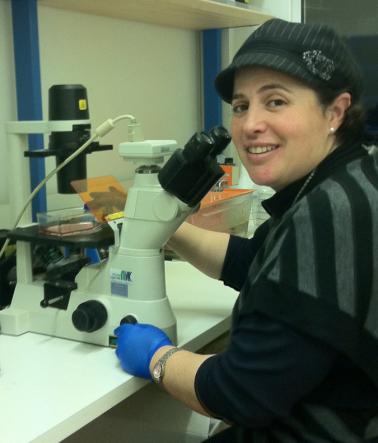By Avigayil Kadesh
A promising new drug against a particularly deadly form of brain cancer is being developed in the lab of Rotem Karni at the Institute for Medical Research Israel-Canada of the Hebrew University-Hadassah Medical School in Jerusalem.
Rotem’s postdoctoral fellow, biochemist Regina Golan-Gerstl, had previously identified a genetic protein – it’s called splicing factor hnRNP A2/B1 -- involved in the spread of glioblastoma, the most common and aggressive type of brain cancer in adults. She and her team explained their groundbreaking discovery in the American Association for Cancer Research journal Cancer Research in 2011.
 Regina Golan-Gerstl, Ph.D.
Regina Golan-Gerstl, Ph.D.Now, says Karni, the Israel Cancer Research Fund-supported investigation is focusing on how to use what they learned to develop a drug to cure glioblastoma, the most common and deadliest of malignant primary brain tumors in adults.
Glioblastoma tumors are nearly impossible to remove with surgery, and rarely respond completely to chemotherapy or radiation. Only about 10 percent of glioblastoma patients live five years or longer after diagnosis. The median survival rate, even with medical intervention, is just over a year.
“We developed some molecules that can inhibit production of this gene,” says Karni.
The gene hnRNP A2/B1 is a naturally occurring substance in the human body. But the Israeli scientists found that in the very early stages of cancer, its production goes into overdrive and enables the cancerous tumor to grow and spread. Golan-Gerstl and her team proved that reducing the amount of hnRNP A2/B1 in lab mice before injecting glioblastoma cells made a dramatic difference in the ability of the cells to proliferate. This group of mice developed only small tumors or no tumors at all, while untreated mice developed large brain tumors when injected with glioblastoma cells.
Karni says they have since shown that the same therapeutic effect takes place in human glioblastoma cells where hnRNP A2/B1 is suppressed, and they are currently studying the technique in further animal models.
“We are developing drugs and new therapies based on these discoveries,” he says. “We believe we have a very important new target for brain cancer therapy.”
A marker for diagnosis and treatment
In collaboration with physicians at Hadassah-Ein Karem Medical Center, Karni and his lab are testing the diagnostic value of this gene in brain-cancer patients. He explains that looking at the level of hnRNP A2/B1 can serve as an unprecedented marker to predict survival of people with glioblastoma tumors, and could help doctors formulate the most effective treatment plan for each patient.
A medication to suppress the gene is the next obvious step. “If we inhibit it, we can really reverse the cancer cells back to normal,” Karni says.
He explains that hnRNP A2/B1 is a “driving oncogene” -- a gene that causes normal cells to become cancerous -- on its own, and probably directly contributes to glioblastoma development.
“Overexpression and amplification of hnRNP A2/B1 correlate with poor prognosis of glioma patients, whereas deletion of the hnRNP A2/B1 gene correlates with better prognosis than average," he says.
According to the National Brain Tumor Society, glioblastoma cells develop primarily in the cerebral hemispheres but also can develop in other parts of the brain, brainstem or spinal cord.
Because it is so often deadly, the glioblastoma was selected as the first brain tumor to be sequenced as part of The Cancer Genome Atlas, a national American effort to map the genomes of the many types of cancer. As a result of this project, researchers discovered that glioblastoma has four distinct genetic subtypes that respond differently to aggressive therapies, making treatment extremely difficult and challenging.
The Israeli discovery has the potential to vastly brighten this grim picture.